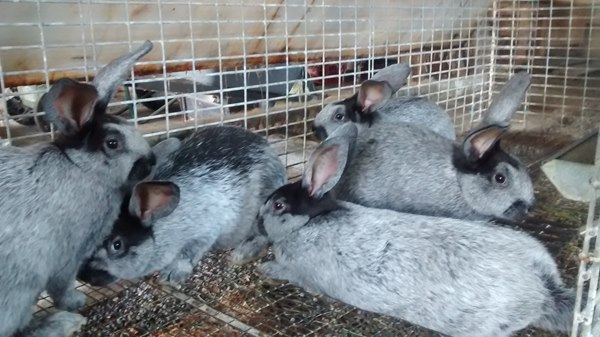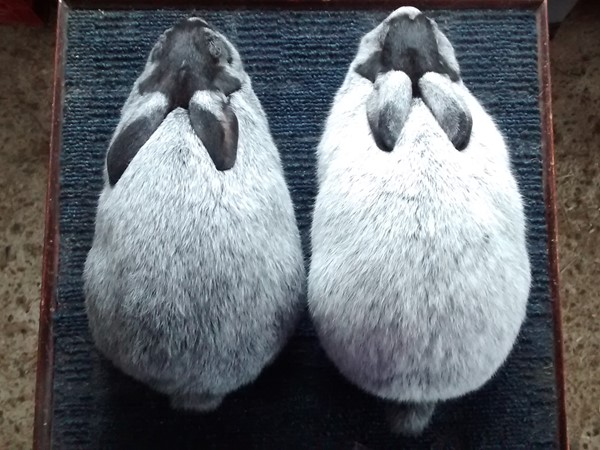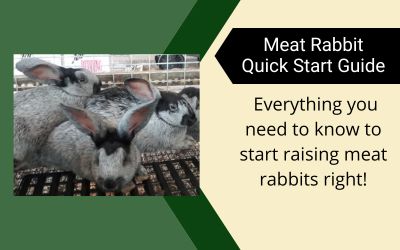
To raise meat rabbits economically, growth rate is very important. Rabbits from good meat lines give you more meat in less time on less feed. Some show rabbits take forever to grow and eat a ton.
Quality breeding stock from thrifty lines quickly pay for themselves in feed savings alone. Purchase rabbits from a breeder who keeps good records. If they can’t tell you what their kits weigh at 8 weeks, look elsewhere.

Good Meat Rabbit Bloodlines
What are good meat lines? They are rabbits that have been selected over generations for fast growth rate, thriftiness, and good meaty body type. The resulting offspring tend to be uniform fast growers. A quality commercial meat rabbit will have small to medium bone. Foot size is a good indicator.
To raise rabbits for meat, choose a large “commercial” rabbit breed with fine bone structure. These rabbits produce fast growing offspring with a good meat to bone ratio, usually 60-65% dress-out rate. Adults usually weigh 8-12 pounds at maturity.
Don’t make the mistake of adding large boned rabbits (such as Flemish Giants) to your breeding program to try to increase growth rates. If you do, you may get 5# fryers at 8 weeks, but they will have hardly any meat on their huge frames. They will eat you out of house and home before they have enough meat to justify butchering at 5-6 months old. Remember, rabbits grow bone before they put on meat.
New Zealand and Californian rabbits tend to be the most popular breeds of rabbits raised for commercial production. The have been selected for large litter size and fast growth.
Personally, I feel that heritage breeds are better suited to backyards and small farms. Click to view the Top 10 Meat Rabbit Breeds for the homestead. We raise Champagne d’Argents. They have more manageable litter sizes (6-8 kits), sweet temperaments, and are good mothers to their kits. Dark eye color also makes them better candidates for pasturing as opposed to Californians and New Zealands which have pink or red eyes.
Meat Rabbit Growth Rate Chart
This chart shows the ideal meat rabbit growth rates for commercial rabbit breeds such as Californians, New Zealands, and Champagne d’Argents. Use these guidelines to see how your stock measures up. Weight is shown in pounds.
| Age | Good Growth | Excellent Growth |
| 6 weeks | 2.7 lbs. | 3-3.25 lbs. |
| 8 weeks | 3.5 lbs. | 4-4.5 lbs. |
| 10 weeks | 5 lbs. | 5.5-6 lbs. |
| 12 weeks | 6 lbs. | 6.5-7 lbs. |
| 16 weeks | 7 lbs. | 7.5-8.5 lbs. |

Invest in a good-quality scale to weigh your rabbits (like this one). I weigh kits at 8 weeks and 12 weeks. You can record growth rates on printable ‘Rabbit Tattoo Log’ sheets from our Rabbitry Records Binder. A scale also allows you to accurately monitor the health and condition of adult rabbits. Pedigree weight of breeding stock is taken at one year.
Hybrid Vigor
A discussion about meat rabbit growth rates would not be complete without mentioning hybrid vigor. If you breed 2 purebred commercial rabbits of different breeds (for example a Californian buck & a New Zealand doe), you get hybrid vigor in the first generation. Those kits will grow fast and be ready to dress out very quickly – assuming the parents are from good meat lines.
A familiar example of hybrid vigor is commercial broiler chickens. Broiler chicks are the result of crossing purebred Cornish with white rock chickens. The resulting chicks grow rapidly and are ready for butcher faster than any other breeds. However, broiler chickens often suffer health problems due to their rapid growth rate. Heart and joint problems are common as well as weak immune systems.
Never make the mistake of saving fast-growing hybrid kits to use as replacement breeders. All of the vigor gained in the first generation is deducted from the second generation. That is why this is often called a “terminal cross”. Crossbred kits from purebred parents are raised strictly for meat and all of them should end up in the freezer.
HYBRID VIGOR PROS: Fast growth rates. It may be easier to put together unrelated pairs of parent stock. Pairing rabbits for hybrid vigor may be a good choice if you raise rabbits strictly for commercial meat production.
HYBRID VIGOR CONS: You can’t perpetuate the herd from your starter rabbits. You need to purchase purebred replacement breeding stock. Since you are only raising one generation, you lose the ability to select for better strains over time. It is critical that you start with rabbits from good meat lines or they will have nothing to contribute to the offspring.
More info on judging quality meat rabbits:
Selecting Meat Rabbit Breeding Stock
Posing Commercial Breed Meat Rabbits
Printable Rabbit Records Binder
How do your meat rabbit growth rates measure up? Do you cross purebred rabbits for hybrid vigor? Tell us about it below…





Is there a chart starting at four weeks? That’s when I first start to weigh all of mine, as they’ve been eating solids for two weeks.
Is the “#” in the chart for lbs?
Yes, sorry for the confusion. I updated the chart to say lbs instead.
Why are meat rabbits harvested at 12 weeks instead of 16 weeks?
Male and female kits must be separated by 12 weeks to grow out to 16 weeks. Since most people have limited cage space or don’t want to bother sexing kits, they butcher at 12 weeks. Another option is to butcher all the bucks at 12 weeks, then butcher the does at 16 weeks for more meat. Pelts from 16 week old rabbits can be saved for tanning.
Can you tell me why brown eyed rabbits do better on pasture?
Great chart. I need to buy a scale already. My Champagnes are about at 8 weeks now.
Great question! White rabbits with pink eyes have albino coloration. According to the Mayo Clinic: “With albinism, the colored parts of the eyes, called the irises, usually don’t have enough pigment. This allows light to shine through the irises and makes the eyes extremely sensitive to bright light.” (Source: https://www.mayoclinic.org/diseases-conditions/albinism/symptoms-causes/syc-20369184 )
Hence, lack of pigment means the sun causes more damage to the eye. Albino humans are told to avoid the sun and wear sunglasses to protect their eyes when outside. Rabbits don’t have that option.
I use a large digital scale. Works great! I put a carpet square on top then tare it to weigh grow-outs. Here’s the type I use: https://amzn.to/3JL7uq9
Great info. Just what I was looking for! I got my first meat rabbit F1 to use for breeding. He is 4 lbs exactly at 8 weeks as a Rex. I think he’ll do.
Congratulations! Sounds like he is right on track. Be sure to check out our ‘Meat Rabbit Quick Start Guide’ if you haven’t already. It has lots of good info to help you avoid common beginner mistakes. https://homesteadrabbits.com/raise-meat-rabbits/
that will be helpful if you add food providing rate per week
thank you ALYSSA
Hi. Awesome information! If I want to select replacement from hybrid kits, how it can be done, correctly?
Thank you!
I’m glad you found this information helpful. As for selecting replacement stock, first generation hybrid kits shouldn’t be kept (that’s why it is called a terminal cross). If you do choose to breed from hybrids, it will take a few generations of selective breeding to regain good growth rates and vigor. See our post on ‘Selecting Quality Stock’ for more info on body type. Hope this helps! https://homesteadrabbits.com/selecting-meat-rabbit-breeding-stock/
I am enjoying the look of the website.. Looking forward to its further development.. I know it takes time.
Thanks for the encouraging words Tim! We will continue to add content as time and resources allow.
Love the new website, Alyssa!!!
Thanks Sam!